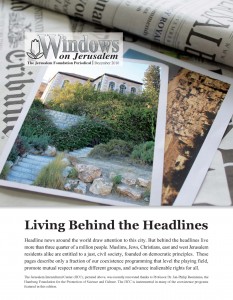Neighbors…. Haredi and non-Haredi in Kiryat Hayovel and Rehavia
Neighbors. Neighbors can be a problem, even in the best of communities. But what happens when neighbors move in who are very different from you? Or when old-time neighbors’ families grow and grow, and seem to be taking over the very nature of your neighborhood? From the ‘other’ side – you’re just looking to living in a nice neighborhood with your family – what’s all the fuss about?
This has been the dynamic in two Jewish neighborhoods – Rehavia and Kiryat Hayovel – that we’ve been working in recently. Both are traditionally secular / national religious neighborhoods – in fact, they’re considered bastions of these populations in Jerusalem. Recently, Kiryat Hayovel has seen an influx of new Haredi residents. In Rehavia, there has always been a Haredi community, but in recent years more and more Haredi families were getting in the neighborhood, changing the demographics. In a city where the Haredi population is growing quickly and non-Haredi populations are feeling threatened, this can definitely cause tensions.
However, if one of our goals is to work to preserve a diverse Jerusalem, tensions are the last thing we need. So in an effort to assuage building tensions between the Haredi and non-Haredi residents of Rehavia and Kiryat Yovel, and thanks to the support of the Jerusalem Foundation and the UJA-Federation of New York, we’re working with 2 very special neighborhood forums.
In Rehavia, we’re working together with the local community council with a group of 20 Haredi and non-Haredi residents, many of them are the leaders of their communities. This includes a fascinating combination of young and older people, national religious, as well as Haredi and secular, men and women. By the end of the second meeting we’d come up with a Summary of Principles for working together. This of course doesn’t mean that individual – and sometimes far-reaching – issues have been solved. But right now we’re focusing on the ‘how we handle issues’, before we move on to the ‘what is the solution’. This includes sometimes basic statements, such as ‘live and let live’, ‘mutual respect’, ‘love of the neighborhood’ and an ’emphasis that we’re all one people’. But we all know that when tension threatens to boil over we need simple, basic principles to guide us through. This group has met twice, and will continue to meet. It has been decided to significantly expand this forum, so that broader agreements can be made and more people and groups can be represented.
In Kiryat Yovel the situation is a bit different. The entrance of Haredi families, even as a small percentage of the population, has raised numerous battle cries against the ‘Haredization’ of Kiryat Yovel, which arises in various forms from time to time. The group in Kiryat Yovel is still smaller – 8 people, all are main leaders – and thus far the two meetings have consist of ‘getting to know you’ conversations. Yet, because Haredi-non-Haredi relations are much terser than in Rehavia, the very existence of these meetings is of utmost importance. While Kiryat Yovel is a tougher nut to crack, we believe we’re on the right path, creating a safe haven for dialogue and conflict resolution. In the last meeting, two Neighborhood Council members hugged each other at the end. This was an unusual occurrence, since one was Haredi and the other was secular who is very active against the Haredization of the neighborhood. “Finally, here, I can give you a hug,” said the Haredi Council member. Another, a secular woman, requested that Haredi women come as well, so that she wouldn’t feel lonely. Currently there is no other place this could happen.
In both neighborhoods, there is energy to continue the processes, and a feeling of hope that is very important for the future of these communities, as well as for Jerusalem.





